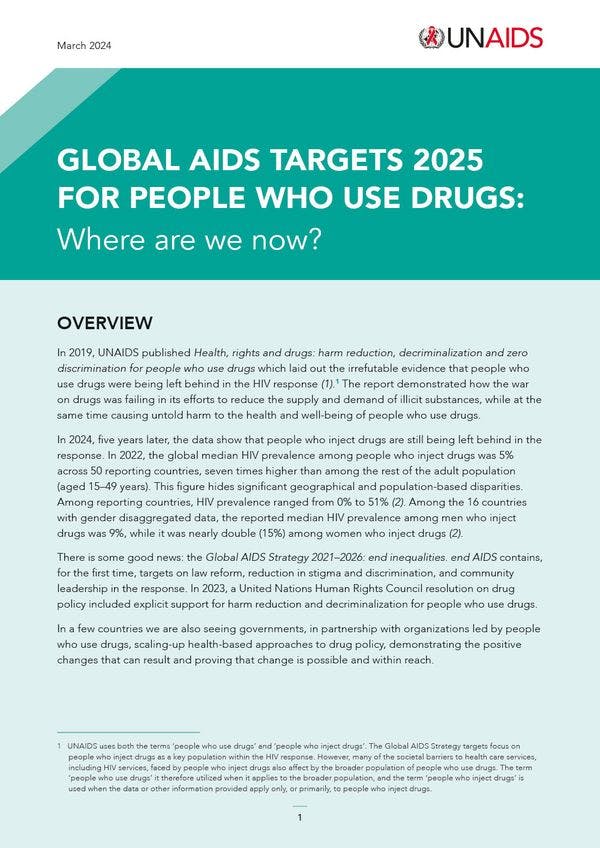Global AIDS targets for people who use drugs in 2025: Where are we now?
In 2019, UNAIDS published Health, rights and drugs: harm reduction, decriminalization and zero discrimination for people who use drugs which laid out the irrefutable evidence that people who use drugs were being left behind in the HIV response. The report demonstrated how the war on drugs was failing in its efforts to reduce the supply and demand of illicit substances, while at the same time causing untold harm to the health and well-being of people who use drugs.
In 2024, five years later, the data show that people who inject drugs are still being left behind in the response. In 2022, the global median HIV prevalence among people who inject drugs was 5% across 50 reporting countries, seven times higher than among the rest of the adult population (aged 15–49 years). This figure hides significant geographical and population-based disparities. Among reporting countries, HIV prevalence ranged from 0% to 51% (2). Among the 16 countries with gender disaggregated data, the reported median HIV prevalence among men who inject drugs was 9%, while it was nearly double (15%) among women who inject drugs.
There is some good news: the Global AIDS Strategy 2021–2026: end inequalities. end AIDS contains, for the first time, targets on law reform, reduction in stigma and discrimination, and community leadership in the response. In 2023, a United Nations Human Rights Council resolution on drug policy included explicit support for harm reduction and decriminalization for people who use drugs.
In a few countries we are also seeing governments, in partnership with organizations led by people who use drugs, scaling-up health-based approaches to drug policy, demonstrating the positive changes that can result and proving that change is possible and within reach.
However, these examples are few and far between. There is a discrepancy between the global commitments at the UN General Assembly and Human Rights Council, and national action. We need an honest discussion on what is and is not working in the current approach, and the importance and urgency of a radical shift. Punitive drug laws and policies create barriers for people who use drugs to access HIV-related services, including but not limited to harm reduction services. These barriers are exacerbated for those experiencing intersecting forms of discrimination, for example on the basis of race, gender, age or migrant status.
While criminalization of drug possession for personal use persists, and as long as harm reduction services remain unavailable and underfunded, it will not be possible to end AIDS as a public health threat. Despite an abundance of evidence on the critical importance of a health-based approach, punitive and coercive policies and practices continue to dominate global drug policy. In 2019 less than 1% of people who inject drugs lived in countries that reported achieving recommended coverage of both needle and syringe programmes and opioid agonist maintenance therapy. Since then no additional country has reported achieving this level of coverage. Possession of drugs for personal use continues to be criminalized in 143 countries. In many cases people who inject drugs remain invisible, with very little data on access to services or experiences of stigma, discrimination or violence. This makes it difficult to effectively plan and implement programmes or monitor progress. A significant and urgent shift from a punitive approach to a public health and human rights-based approach to drug policy is needed.
UNAIDS estimates that to meet 2030 targets, the resources needed for prevention programmes amount to US$ 2.7 billion for interventions serving people who inject drugs in lower- and middle-income countries, 89% of which would be needed in middle-income countries. A further US$ 3.1 billion (11% of total estimated resource needs for the HIV response) per year is needed for enablers, including: programmes addressing human rights; policy dialogue; reduction of stigma, discrimination and gender-based violence; and HIV related legal services.
The Global AIDS Strategy 2021–2026 outlines what must be done if AIDS is to be ended as a public health threat by 2030. Specifically, it summarizes the evidence-based, critical shift needed to implement an effective public health approach for people who use drugs. The strategy therefore includes specific targets for people who inject drugs, including in relation to combination prevention, testing and treatment, societal enablers and community-led responses. These targets are aligned with the WHO evidence-based and prioritized package of interventions for people who inject drugs. This fact sheet serves as a reminder of these global commitments and provides an update on progress, as well as recommendations on what needs to be done to improve progress.
